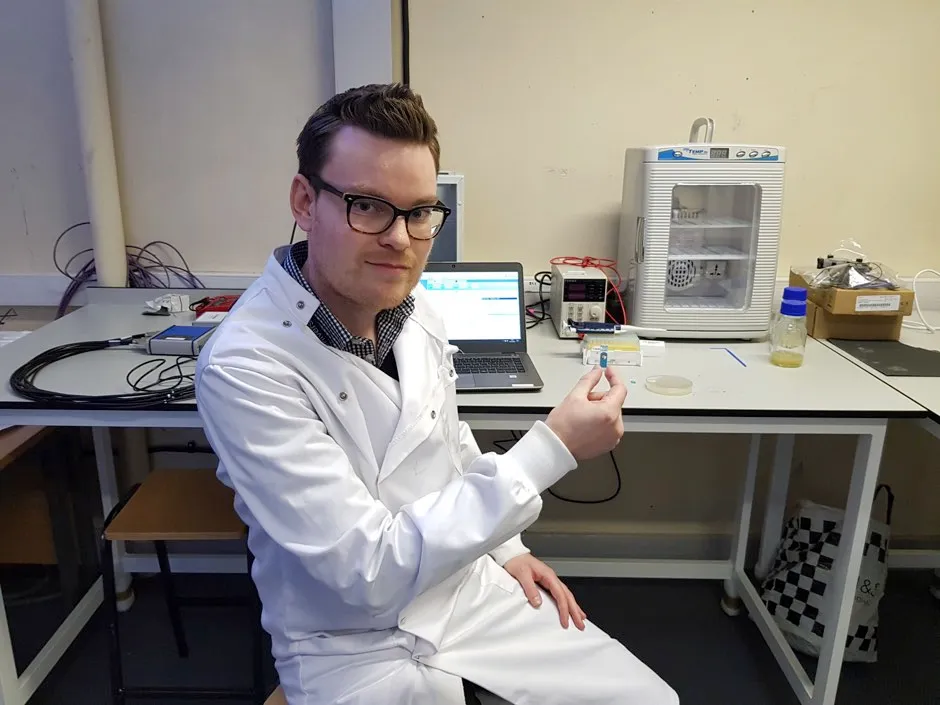A diagnostic test is being developed by scientists that would cut the time taken to show resistance to antibiotics from “up to two days” to “less than 45 minutes”.
In a research paper published in the journal Biosensors and Bioelectronics, the University of Strathclyde team demonstrated the low-cost, rapid diagnostic system.
To prove it could prescribe the correct antibiotic to a patient for an infection more quickly, the scientists examined the difference in growth profiles between staphylococcus aureus and MRSA.
While the former is a common hospital-acquired bacterial infection sensitive to antibiotics, MRSA can be harder to treat.
Both strains were placed on to electrodes covered in a special hydrogel deposit and the susceptible strain could not grow when the sensor was seeded with antibiotic.
Rapid result detection means you could pinpoint bacterial versus viral infections straight away and would be able to start working on the correct treatment more quickly for patients
Dr Stuart Hannah
The paper’s lead author, Dr Stuart Hannah, said: “There is a small difference between what makes an organism susceptible to an antibiotic and what makes it resistant.
“In real terms, we were able to distinguish between the two strains in less than 45 minutes, which is a significant improvement on the current gold standard of up to two days.
“The technology uses a low cost, commercially available sensor which acts like a mini culture dish that can deal with any kind of clinical sample.
Read more about antibiotic resistance:
- Antibiotic resistance: is it really as bad as climate change?
- 9 of the most dangerous antibiotic-resistant bacteria
- Compound found in cannabis shows promise as a powerful antibiotic
“The system is modified with a special gel deposit so that we can identify the difference between susceptible and resistant forms of common bacteria.
“Rapid result detection means you could pinpoint bacterial versus viral infections straight away and would be able to start working on the correct treatment more quickly for patients, which is very important for particular infections.
“Antibiotic resistance is less likely to develop if you give a narrower spectrum antibiotic.”
It is now hoped the test could be used by pharmacists and other points of care, as well as being developed for commercial use.
Reader Q&A: What causes antibiotic resistance?
Asked by: Eddie Friel, Hull
Antibiotic resistance is a good example of natural selection. Exposure to antibiotics increases selective pressure in bacterial populations, boosting the percentage of resistant bacteria, with new bacterial generations inheriting resistance genes. Bacteria can sometimes pass on resistance by sharing genetic material with each other.
They can also become resistant following spontaneous changes to their genes. Some gene mutations allow bacteria to produce enzymes that inactivate antibiotics.
Others change their outer structure so that antibiotics can’t gain access. Some bacteria even develop pumping mechanisms to expel antibiotics.
Overuse and misuse of antibiotics has exacerbated the problem of antibiotic resistance.
Read more:
Dr Hannah suggested all the materials used “can be mass manufactured, which means that it is cheap to produce a working test”.
He added: “With the right commercial backing, a future device could be used at a GPs’ surgery, where they could effectively take a blood sample and do the test and have results within the hour, rather than sending samples to a laboratory and have to wait for a positive result.
“It could also have a place on intensive care wards. The first time someone is ill they are quite rightly given a broad spectrum antibiotic and also they have to wait for 12-72 hours for a result from the hospital laboratory.
“We would hope that the test can be located at the bedside and that it will allow doctors to switch from a broad spectrum agent to the right drug quite quickly.”

The consultant anaesthetist on the project, Dr David Alcorn from the Royal Alexandra Hospital in Paisley, said: “Being able to quickly diagnose an infection is a great enough ability but to be able to also detect AMR (antimicrobial resistance) within such a short period of time could prove to be a wonderful tool.
“It means that vital diagnostic information could be provided for clinicians across intensive care units, operating theatres, and emergency departments, to enable them to give the right drug at the right time.
“There is also scope for this to have an enormous impact within general practice and day-to-day healthcare.”
